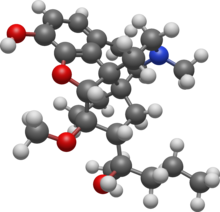 | |
 | |
| Clinical data | |
|---|---|
| ATC code |
|
| Legal status | |
| Legal status |
|
| Identifiers | |
| |
| CAS Number | |
| PubChem CID | |
| DrugBank | |
| ChemSpider | |
| UNII | |
| KEGG | |
| CompTox Dashboard (EPA) | |
| ECHA InfoCard | 100.214.784 |
| Chemical and physical data | |
| Formula | C25H35NO4 |
| Molar mass | 413.558 g·mol−1 |
| 3D model (JSmol) | |
| |
| |
| (verify) | |
Dihydroetorphine was developed by K. W. Bentley at McFarlan-Smith in the 1960s[1] and is a potent opioid analgesic[2] used mainly in China. It is a derivative of the better-known opioid etorphine, a very potent veterinary painkiller and anesthetic medication used primarily for the sedation of large animals such as elephants, giraffes, and rhinos.
Dihydroetorphine is a semi-synthetic opioid used mainly as a strong painkiller for humans.[3] It is several thousand times stronger than morphine (between 1000× and 12000× more potent depending what method is used for comparison),[1] although it is poorly absorbed when taken orally. Sublingual forms of dihydroetorphine are used in China at doses ranging from 20 to 40 μg repeated every 3–4 hours, and are reported to cause strong analgesia and relatively mild side effects compared to other opioids, although all the usual opioid side effects such as dizziness, sedation, nausea, constipation, and respiratory depression can occur. Transdermal patches of dihydroetorphine have also been developed.[4]
Dihydroetorphine is considered to be somewhat less addictive than many other opioids, and it is also sometimes used in China as a substitute maintenance drug for opioid addicts,[5] in a similar fashion to how the related drug buprenorphine is used in western nations.[6][7] It is presumably controlled as an "ester, ether, [or] salt" of etorphine in the United States under the Controlled Substances Act 1970, and/or its pieces of the morphine carbon skeleton put it under the "morphine rule" thereof and/or the 1986 analogues act; it does not have its own ACSCN.[8] Regulation elsewhere may vary but would likely be similar to that for other strong opioid agonists.[citation needed]
Dihydroetorphine is illegal in Italy, as are its parent compounds etorphine and acetorphine.[9]
- ^ a b Bentley KW, Hardy DG (June 1967). "Novel analgesics and molecular rearrangements in the morphine-thebaine group. 3. Alcohols of the 6,14-endo-ethenotetrahydrooripavine series and derived analogs of N-allylnormorphine and -norcodeine". Journal of the American Chemical Society. 89 (13): 3281–92. doi:10.1021/ja00989a032. PMID 6042764.
- ^ Martin TJ, Hairston CT, Lutz PO, Harris LS, Porreca F (September 1998). "Anti-allodynic actions of intravenous opioids in the nerve injured rat: potential utility of heroin and dihydroetorphine against neuropathic pain". European Journal of Pharmacology. 357 (1): 25–32. doi:10.1016/S0014-2999(98)00531-7. PMID 9788770.
- ^ Lewis JW, Husbands SM (2004). "The orvinols and related opioids--high affinity ligands with diverse efficacy profiles". Current Pharmaceutical Design. 10 (7): 717–32. doi:10.2174/1381612043453027. PMID 15032698.
- ^ Ohmori S, Morimoto Y (2002). "Dihydroetorphine: a potent analgesic: pharmacology, toxicology, pharmacokinetics, and clinical effects". CNS Drug Reviews. 8 (4): 391–404. doi:10.1111/j.1527-3458.2002.tb00236.x. PMC 6741694. PMID 12481194.
- ^ Bo-Yi Q (1996). "Advances in dihydroetorphine: From analgesia to detoxification". Drug Development Research. 39 (2): 131–134. doi:10.1002/(SICI)1098-2299(199610)39:2<131::AID-DDR3>3.0.CO;2-Q. S2CID 201878290. Archived from the original on 2013-05-25. Retrieved 2017-09-09.
- ^ Gerak LR, Gauthier CR, France CR (April 2003). "Discriminative stimulus and antinociceptive effects of dihydroetorphine in rhesus monkeys". Psychopharmacology. 166 (4): 351–9. doi:10.1007/s00213-002-1268-y. PMID 12601499. S2CID 23944183.
- ^ Husbands SM, Lewis JW (March 2003). "Opioid ligands having delayed long-term antagonist activity: potential pharmacotherapies for opioid abuse". Mini Reviews in Medicinal Chemistry. 3 (2): 137–44. doi:10.2174/1389557033405395. PMID 12570846.
- ^ "DEA Diversion Control Division". Archived from the original on 2016-03-02. Retrieved 2016-02-27.
- ^ Salute, Ministero della. "Tabelle delle sostanze stupefacenti e psicotrope". www.salute.gov.it (in Italian). Retrieved 2022-04-09.